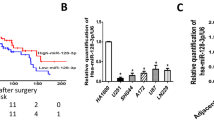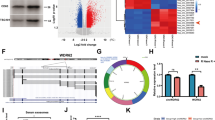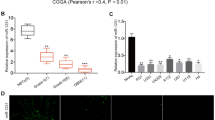Abstract
MicroRNA is an important regulator of glioblastoma. This study aims at validating microRNA-221 (miR-221) as a biomarker for glioblastoma, and understanding how miR-221 regulates glioblastoma progression. Using clinical samples, miR-221 expression was analyzed by quantitative reverse-transcriptase PCR (qPCR). SHG-44 cells were treated with anti-miR-221 or U87MG-derived exosomes followed by monitoring changes in cell viability, migration and temozolomide (TMZ) resistance. Bioinformatics approach was used to identify targets of miR-221. The interaction between miR-221 and its target, DNM3 gene, was studied with dual-luciferase reporter assay, Spearman’s correlation analysis, and western blotting. To verify that RELA regulates miR-221 expression, RELA-expressing vector or shRNA was introduced into SHG-44 cells and its effect on miR-221 expression was monitored. Both tissue-level and exosomal miR-221 expression increased with glioma grades. In SHG-44 cells, downregulating miR-221 expression inhibited cell proliferation, migration, and TMZ resistance, whereas incubation with U87MG-derived exosomes exerted tumor-promoting effects. DNM3 gene is a target of miR-221. RELA induced miR-221 expression. In glioma, elevated miR-221 expression is a biomarker for glioma. DNM3 is a target of miR-221 and RELA regulates miR-221 expression. The RELA/miR-221 axis is a target for glioma diagnosis and therapy.






Similar content being viewed by others
References
Omuro A, DeAngelis LM (2013) Glioblastoma and other malignant gliomas: a clinical review. JAMA 310:1842–1850. doi:10.1001/jama.2013.280319
DeAngelis LM (2001) Brain tumors. N Engl J Med 344:114–123
Louis DN (2006) Molecular pathology of malignant gliomas. Annu Rev Pathol Mech Dis 1:97–117
Calin GA, Croce CM (2006) MicroRNA-cancer connection: the beginning of a new tale. Cancer Res 66:7390–7394
Ciafre S, Galardi S, Mangiola A, Ferracin M, Liu C-G, Sabatino G, Negrini M, Maira G, Croce C, Farace M (2005) Extensive modulation of a set of microRNAs in primary glioblastoma. Biochem Biophys Res Commun 334:1351–1358
Azmi AS, Bao B, Sarkar FH (2013) Exosomes in cancer development, metastasis, and drug resistance: a comprehensive review. Cancer Metastasis Rev 32:623–642
Yang C, Robbins PD (2011) The roles of tumor-derived exosomes in cancer pathogenesis. Clin Dev Immunol 2011:842849
Liu M, Liu J, Wang L, Wu H, Zhou C, Zhu H, Xu N, Xie Y (2014) Association of serum microRNA expression in hepatocellular carcinomas treated with transarterial chemoembolization and patient survival. PloS One 9:e109347
Tao K, Yang J, Guo Z, Hu Y, Sheng H, Gao H, Yu H (2014) Prognostic value of miR-221-3p, miR-342-3p and miR-491-5p expression in colon cancer. Am J Transl Res 6:391–401
Yau T, Wu C, Dong Y, Tang C, Ng S, Chan F, Sung J, Yu J (2014) MicroRNA-221 and microRNA-18a identification in stool as potential biomarkers for the non-invasive diagnosis of colorectal carcinoma. Br J Cancer 111:1765–1771
Zheng Q, Peskoe SB, Ribas J, Rafiqi F, Kudrolli T, Meeker AK, De Marzo AM, Platz EA, Lupold SE (2014) Investigation of miR-21, miR-141, and miR-221 expression levels in prostate adenocarcinoma for associated risk of recurrence after radical prostatectomy. Prostate 74:1655–1662
Chen L, Zhang J, Han L, Zhang A, Zhang C, Zheng Y, Jiang T, Pu P, Jiang C, Kang C (2012) Downregulation of miR-221/222 sensitizes glioma cells to temozolomide by regulating apoptosis independently of p53 status. Oncol Rep 27:854–860. doi:10.3892/or.2011.1535
Zhang C-Z, Zhang J-X, Zhang A-L, Shi Z-D, Han L, Jia Z-F, Yang W-D, Wang G-X, Jiang T, You Y-P (2010) MiR-221 and miR-222 target PUMA to induce cell survival in glioblastoma. Mol Cancer 9:1
Hao J, Zhang C, Zhang A, Wang K, Jia Z, Wang G, Han L, Kang C, Pu P (2012) miR-221/222 is the regulator of Cx43 expression in human glioblastoma cells. Oncol Rep 27:1504
Zhang Z, Chen C, Guo W, Zheng S, Sun Z, Geng X (2016) DNM3 attenuates hepatocellular carcinoma growth by activating P53. Med Sci Monit 22:197–205. doi:10.12659/msm.896545
Chen X, Ba Y, Ma L, Cai X, Yin Y, Wang K, Guo J, Zhang Y, Chen J, Guo X (2008) Characterization of microRNAs in serum: a novel class of biomarkers for diagnosis of cancer and other diseases. Cell Res 18:997–1006
Ujifuku K, Mitsutake N, Takakura S, Matsuse M, Saenko V, Suzuki K, Hayashi K, Matsuo T, Kamada K, Nagata I, Yamashita S (2010) miR-195, miR-455-3p and miR-10a(*) are implicated in acquired temozolomide resistance in glioblastoma multiforme cells. Cancer Lett 296:241–248. doi:10.1016/j.canlet.2010.04.013
Pereira DM, Rodrigues PM, Borralho PM, Rodrigues CM (2013) Delivering the promise of miRNA cancer therapeutics. Drug Discov Today 18:282–289
Kohsaka S, Wang L, Yachi K, Mahabir R, Narita T, Itoh T, Tanino M, Kimura T, Nishihara H, Tanaka S (2012) STAT3 inhibition overcomes temozolomide resistance in glioblastoma by downregulating MGMT expression. Mol Cancer Ther 11:1289–1299. doi:10.1158/1535-7163.MCT-11-0801
Zhang C, Kang C, You Y, Pu P, Yang W, Zhao P, Wang G, Zhang A, Jia Z, Han L (2009) Co-suppression of miR-221/222 cluster suppresses human glioma cell growth by targeting p27kipl in vitro and in vivo. Int J Oncol 34:1653
Orth JD, McNiven MA (2003) Dynamin at the actin–membrane interface. Curr Opin Cell Biol 15:31–39
Inokawa Y, Nomoto S, Hishida M, Hayashi M, Kanda M, Nishikawa Y, Takeda S, Fujiwara M, Koike M, Sugimoto H, Fujii T, Nakayama G, Yamada S, Tanaka C, Kobayashi D, Kodera Y (2013) Dynamin 3: a new candidate tumor suppressor gene in hepatocellular carcinoma detected by triple combination array analysis. Onco Targets Ther 6:1417–1424. doi:10.2147/OTT.S51913
Hwang SK, Baker AR, Young MR, Colburn NH (2014) Tumor suppressor PDCD4 inhibits NF-kappaB-dependent transcription in human glioblastoma cells by direct interaction with p65. Carcinogenesis 35:1469–1480. doi:10.1093/carcin/bgu008
Acknowledgements
The authors would like to thank Dr. Li-qun Wang, Dr. Zhong-qiang Lv, and Dr. Zong-mao Zhao for their technical advice.
Funding
This study was supported by the Program of Graduate students innovation fund of Hebei Province.
Author information
Authors and Affiliations
Corresponding author
Ethics declarations
Conflict of interest
The authors declare that they have no competing interests.
Ethical approval
The protocols approved by the Committee on the Ethics of Animal Experiments of The Second Hospital of Hebei Medical University.
Electronic supplementary material
Below is the link to the electronic supplementary material.
Rights and permissions
About this article
Cite this article
Yang, JK., Yang, JP., Tong, J. et al. Exosomal miR-221 targets DNM3 to induce tumor progression and temozolomide resistance in glioma. J Neurooncol 131, 255–265 (2017). https://doi.org/10.1007/s11060-016-2308-5
Received:
Accepted:
Published:
Issue Date:
DOI: https://doi.org/10.1007/s11060-016-2308-5




